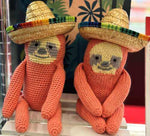*** Free UK delivery on orders over £75 ***
Menu
-
- New
-
Yarn
- Stitching
-
Hooks & Needles
-
Accessories
-
All Accessories
- Blocking
- Books and Magazines
- Buttons
- Cable Needles
- Chart Keepers
- Darning Needles and Pins
- Needle and Hook Cases
- Notebooks and Stationery
- Pom Poms
- Row Counters
- Rulers and Needle Gauges
- Scissors
- Sewing
- Stitch Holding Cords
- Stitch Markers
- Stitch Stoppers
- Swifts and Winders
- Wool Wash
- Yarn Bowls
- Yarn Snugs
- Other
- Bags
- Brands
-
All Accessories
-
Patterns & Kits
-
Gifts
- Sale
-
How to & Ideas
-
- Login

*** Free UK delivery on orders over £75 ***
What Is Fingering Weight Yarn?
April 01, 2021 5 min read

What is fingering weight yarn?
Contents
What ply is fingering yarn?
Before we can answer this question, it's important to understand what a ply is. Look closely at a length of yarn, and you'll see that it actually consists of several smaller fibres, like threads, that are wound tightly together. Each of these threads is a ply. Some yarns may have several plies, while others have only one.
You'll often see fingering yarn referred to as 4 ply; in fact, the two terms are used interchangeably by many knitters today. To understand why this is the case, we have to take a look back in time to the mid-20th century.
Until the post-war era, yarn weight was standardised; every ply produced for commercial use was the same thickness. This meant that the term "4 ply yarn" had a very clear, standard meaning. Nowadays, things have changed, with some companies producing thicker or thinner plies. Nevertheless, the term 4 ply for fingering weight yarn remains in use.
In practice, you can find fingering yarn with different numbers of plies. This will affect its strength and durability, as we'll talk about later.
What is fingering weight yarn also known as?
As always in the world of yarn, terminology changes from country to country. For example, in the US fingering weight yarn is also known as number 1 or superfine yarn. When you're looking at patterns produced by knitters from around the world, these words mean that you'll be dealing with a fingering weight yarn equivalent:

The terminology can be particularly confusing as some words overlap between categories. When you start a project, always be sure to look at the knitting tension, and practise with a gauge swatch. This will help you see if your yarn is a good fit for the pattern.
What size needles should be used with fingering yarn weight?
In general, you can expect to use small needles when working with this lightweight yarn. Many patterns recommend needles between 2.5 and 3.5 mm. This will give you a finished fabric that is tight without being stiff. Crocheters will generally find that a hook size of 2.25 - 3.5 mm is recommended.
It's important to bear in mind that the nature of your project will affect the size of your needles. If you're making socks, you'll want a firm gauge that results in a snug, tight-fitting item. However, this yarn is also commonly used for shawls, scarves, and other pieces of lightweight lace. In this case, larger needles will give an airier, more delicate effect.
This weight of yarn is often used to make clothes and accessories for babies. In this case, you'll want to make sure your gauge is firm enough to create a gap-free fabric. Loose knitting with large needles may not work here, as you could end up with gaps large enough for little fingers to slip through and get stuck.
What is fingering yarn good for?
Some of the most common projects that use this yarn include socks, lacework, and baby clothes. It's perfectly possible to make adult garments with lightweight yarn, but be prepared: as you'll be working with small needles, you may have a very long task ahead of you!
Making shawls, scarves, and cowls
These accessories don't need to be especially durable; as they are not worn on the body in the same way as a jumper or a pair of socks, they won't rub and pill easily. As a result, they can be made with fancy blends of yarn. Silk, soft merino wool, alpaca and mohair may all be used here. You can expect different effects: when you use alpaca or mohair, for example, your item will have a soft, fuzzy halo. This looks great with an open lace pattern.
These projects are also ideal for using single ply yarn. You'll find that this is a softer alternative to tightly wound multi-ply yarns. It has a lovely feel, squishy to the touch, and is great for cosy scarves or cowls.
Many small, artisan spinners and dyers produce exquisite skeins of fingering yarn weight, hand-dyed with variegated colours. It's possible to make a shawlette or mini scarf from just one skein, so many knitters enjoy this opportunity to showcase a special colourway.
Take care when matching your yarn to a pattern. If you've gone for a stunning, variegated colourway, then it's best to keep your pattern simple. It can be hard to see complex lacework if it's buried in self-striping yarn.
What is fingering yarn for socks?
This weight of yarn is ideal for making socks, but you'll have to choose your particular yarn carefully. Look for skeins that are specifically labelled as sock yarn. Making a pair of socks involves quite a bit of effort - make sure that your finished object will last!
Socks need to be very durable, as they will rub against the inside of your shoes all day. Single ply is entirely inappropriate here, and so are delicate blends of silk or mohair. There are two key components of most sock yarns: first, they are usually about 25% nylon. This makes them more durable, stopping holes from developing at the toes or the heels. Secondly, they are often given a superwash treatment, so you can wash them in the machine, rather than going through the rigmarole of hand-washing.
Self-striping sock yarns are fun to work with, and will create a pattern as you knit. For the average adult, you'll need about 100g of yarn to make a pair of socks.

Working with baby yarn
The term "baby yarn" can refer to either sport or fingering weight yarn, so don't forget your gauge swatch! These yarns are intended for clothes and accessories for babies and toddlers, and usually have a few particular features.
Baby yarn often has a superwash treatment. After all, who has time for handwashing with a baby around? It is usually very soft; often it is made from merino, rather than regular wool, which can scratch a baby's delicate skin. Finally, it is unlikely to have any fuzzy components such as mohair. That soft halo, which can be so appealing in a lacy shawl, might lead to the baby accidentally swallowing fibres.
While baby yarn can be used to make garments for adults, too, its particular properties make it especially well-suited for little ones. Before beginning a project for a baby, ask about allergies. There are soft acrylic or cotton-blend baby yarns which are suitable for youngsters who suffer a reaction to wool. These are also the best choice for clothing for warmer climates.
Subscribe to this blog's RSS feed using https://www.yarnworx.com/blogs/yarn-guides.atom
Also in Yarn Guides

What is boucle yarn?
March 21, 2025 2 min read
Boucle yarn is a popular material for knitting that creates a unique textured fabric. Learn everything you need to know about boucle with our in depth guide!

How to crochet a magic circle
May 19, 2023 4 min read

5% off your first order when you join our email newsletter...
Be the first to know of new product releases and other exciting news! A discount code will be sent to your email straight away!



